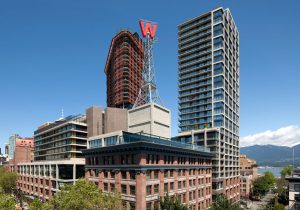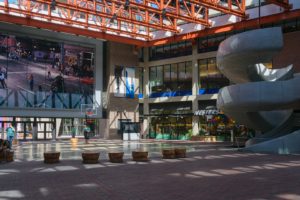Built in 1903, when there were 60,000 people living in the city, Woodward’s was geographically split between the premier downtown shopping destinations to the west and the concentration of transient housing and brothels to the east, providing goods to working- and middle-class residents.
The original building’s history itself runs analogous to that of the City of Vancouver; the spinning “W”, a landmark. 
Ten years after the first residents moved in to the Woodward’s Building in Vancouver, the block at Hastings and Abbott Street is a vibrant hub—the site wasn’t only revitalized, it brought back a beating heart to the historic district.
Gregory Henriquez, architect behind the “experiment,” describes it as a rebirth.
Kornfeld LLP acted as counsel to the Westbank Group, a co-developer of the Woodward’s redevelopment project.
“The Best for Less”
Woodward’s Department Store provided an anchor for many of B.C.’s shopping districts into the 1970s, when sales at the flagship store on Hastings Street began to decline.
After 100 years, the store closed and sat vacant for little more than a decade before being demolished in 2006.
In Body Heat: The Story of the Woodward’s Redevelopment, Westbank Group President, Ian Gillespie, said Woodward’s was the most complicated project he had encountered as a mixed-use commercial real estate developer in Vancouver.
After already constructing four of the tallest buildings that stood in the city at the time, Gillespie said that due to the number of people and agencies involved with Woodward’s, the other developments didn’t compare.
“The truth is there isn’t a deal that is this complicated. It doesn’t exist,” he said.
The book, published in 2010, contains 23 interviews with key participants in the redevelopment process and full-page photos of the project before, during and after the historic undertaking.
Combining a public university, with below-market social housing, and luxury condos with retail space, set Woodward’s apart from what had been possible in Vancouver before then. See “How Vancouver’s Woodward’s could pave the future of dying department stores”
Our firm
Neil Kornfeld, Q.C. led the project, with the firm’s real estate development group, which involved the assembly of the land and rezoning, followed by the conventional, airspace and strata subdivisions of the project’s components, the sale of those components and the leasing of others.
The project was so extensive as to engage virtually every practice group with our firm.
“It’s a matter of bringing new people in.”
The building provided 200 non-market residential units—more than twice than what was required by the city.
Kornfeld LLP’s services involved obtaining heritage designation and transfer of density, as well as the negotiation of the non-market housing agreements and agreements with the city for the complex structuring of the public use rights for portions of the development.
Public consultations were integral to the success of the project and when the city purchased the site from the province in 1992, they knew that the city’s residents needed to be heard and public ideas incorporated into the final structure.
The community partners and leadership, under municipal leaders like Jim Green and Michael Flanigan, came together on a project that surpassed the odds of what could be done to revive a neglected area.
Gillespie said at the outset that Woodward’s made no sense but it didn’t matter. Civic pride and the challenge of recreating the abandoned space drew him in, despite the enormous undertaking and correct assumption of numerous setbacks.
The challenge was accepted, however, and our firm saw it through, with minimal time lost for our clients and the entire project. Invaluable relationships were established with the city and other members of the real estate community.
In addition to the non-market residential units, the complex housed 536 market residential units, government offices, a child daycare, as well as retail and commercial spaces.
In the book, Gillespie was asked what his measure of success would be for the project; that Woodward’s wasn’t just a noble social experiment, but that had desirable change in the Downtown Eastside:
“The first thing that comes to mind is warm bodies on the street. People with money in their pockets going to London Drugs; or going to the grocery store; or students going to Simon Fraser; or people going to the plaza. I think the neighbourhood misses a sense of normality. Everything is always in crisis. It’s not a matter of pushing people out; it’s a matter of bringing new people in. Normality may be the wrong word, but that is one of the reasons we pushed so hard to finish the deal with Simon Fraser. I think it will be one of the important legacies to come out of this project. I really believe in this comparison with NYU: the whole idea of dropping a campus in the middle of the neighbourhood and having it change the neighbourhood for the better. It’s not a bunch of GAP stores, it’s a bunch of kids who aren’t freaked out by a different kind of neighbourhood, who have the ability to bring positive energy to a place that desperately needs it.”
The decision to showcase a colossal photomural depiction of the 1971 Gastown Riot in the public-private courtyard at the centre of the site, by artist Stan Douglas, lent to the idea that Woodward’s was something new, and bold. Douglas said he chose to recreate and photograph scenes from the riot because of its artistic fit with the social experiment to bring different groups together and change the area.

By Xicotencatl – Own work, CC BY-SA 4.0
Like a century ago, the site bridges class dynamics and provides a place to buy household goods and groceries, immersed in the bustle of a breathing, changing city.
